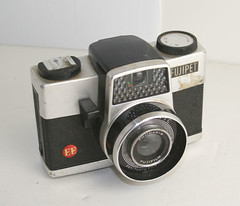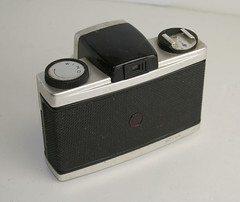Fujipet
With an aluminium and plastic body, the Fujipet (フジペット)[1] taking 6×6cm pictures on 120 film is often considered a "toy camera," probably due to the toylike appearance and its single-element meniscus lens. It was made by Fuji from 1957 to 1963[2] and was released for sale exclusively in Japan, marketed as a camera for the whole family. It is said that it was designed by Nishimura Masaki (西村雅貴), former head of Kōnan, and Tanaka Yoshio (田中芳郎), professor at the Tokyo University of Arts.[3]
A leaflet advertising the camera had factual information in Japanese only, and the following text in English only:
- With the Fujipet Camera you can the pictures very easily just as you manipulate your knife and fork. So you are a good photographer from the instant when you have bought the Fujipet Camera. The Fujipet Camera enjoys great popularity among children, mothers and all the members of the family and affords happiness in all homes.
Description
The original Fujipet is characterised by a streamlined conical viewfinder, which gave rise to its colloquial appellation Fujipet 'Thunderbird.' Top and bottom plate as well as the removable back and the lens shade are of aluminium, the body and viewfinder are plastic. The lens has levers on each side, the left to cock the shutter and the right to release it. Aperture selection is via a lever. There the aperture values are indicated in different colours (to the left of the lens[4]. On the opposite side are the same values expressed as sunny, cloudy and dark, with corresponding colours. On top is a third representation with corresponding colours showing a decreasing size of the aperture. On the back of the camera is a single red window with a swivelling cover.
Over time, the amount of plastic increased. In the second version of the Fujipet, the metal lens shade is replaced with a plastic one, the cover for the red window is omitted and the position of the flash contact changed. In the first model it is below the lens shade, while in the second model the lens shade must be extended to reveal the plug.
The Fujipet comes in a range of body colours, grey (most common), black, burgundy red, dark green, dark blue, and brown. Some bodies have a gold rather than silver trim of the metal surfaces. The total production was nearly 1 million.
Technical Specifications
Lens: simple Meniscus lens of glass, later plastic; 70mm f/11
Aperture options: f11, f16, f22
Shutter: leaf shutter with B and I (= ~1/50th sec); requires cocking
Focus: fix focus, ~ 1m to infinity
Dimensions:120x100x75mm, weight:332g.
Flash shoe: Cold shoe
Subsequent models
- The Fujipet 120EE, introduced in 1961, has a large selenium cell above the lens that automatically selects the aperture. The shutter is self cocking (hence only one lever). The top of the lens surround reads 'ELECTROMATIC'. The camera carries a small red badge with 'EE' in gilt letters at the bottom left front panel.
- The Fujipet EE ('EE-2') has a meter sensitivity knob added and the lens changed. The top of the lens surround now reads 'AUTOMATIC' and and the lens bezel states 'FUJINAR-S FUJIFILM.' The camera carries a small gilt badge with 'EE' in red letters at the bottom left front panel.
- The Pet 35 introduced in 1959 is a 35mm version of the camera. As with the original Fujipet, the shutter is manually cocked (hence two levers), but the lens has front cell focussing.
 
|
| Fujipet EE images courtesy Jay Tepper (Image rights) |
Notes
- ↑ also known as 'Fujipetto'
- ↑ All Fujipets are stamped underneath the top plate which gives both the inspection date and the name of the inspector.
- ↑ Page on the Fujica Mini at Mediajoy's Guide to Classic Cameras (also in in Japanese).
- ↑ When looking at the lens.
Bibliography
- Asahi Camera (アサヒカメラ) editorial staff. Shōwa 10–40nen kōkoku ni miru kokusan kamera no rekishi (昭和10–40年広告にみる国産カメラの歴史, Japanese camera history as seen in advertisements, 1935–1965). Tokyo: Asahi Shinbunsha, 1994. ISBN 4-02-330312-7. Items 1486–7 and 1489.
Links
In English:
- Fujipet GO! / Fujipet Goodies / Fujipet Maintenance / Fujipet manuals / Fujipet Instax Mini conversion by Sean Rhodes on moomminstuff
- Fujipet and Fujipet EE (with original boxes), lot no.682 of the fourth Westlicht Photographica Auction on 22 November 2003
- Page on the Fujica Mini (also in in Japanese) at Mediajoy's Guide to Classic Cameras, giving the name of the designers of the Fujipet
In Japanese:
- Fujipet EE in the Center of the History of Japanese Industrial Technology
- Fujipet EE in the second page of the Yamada Camera Museum
